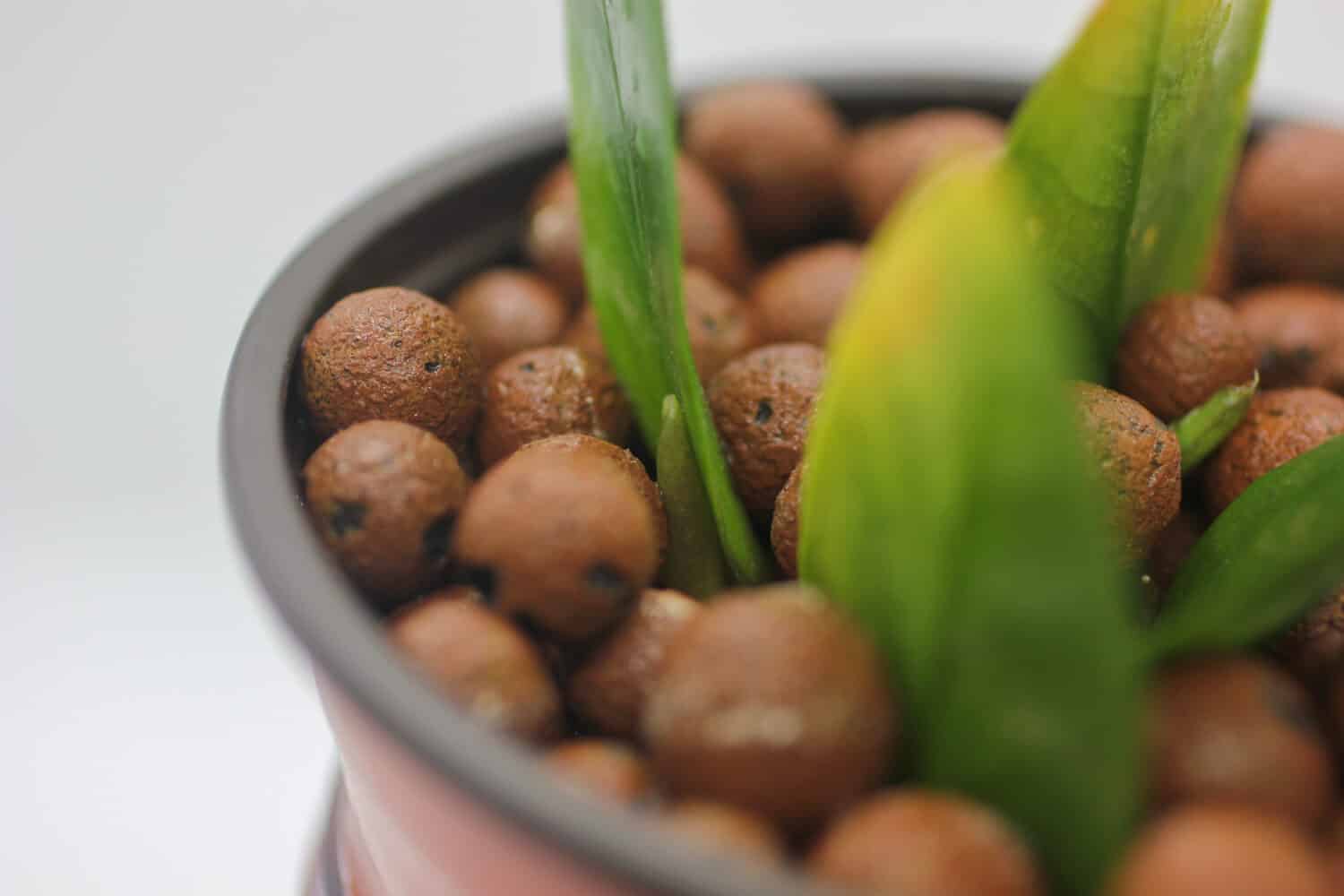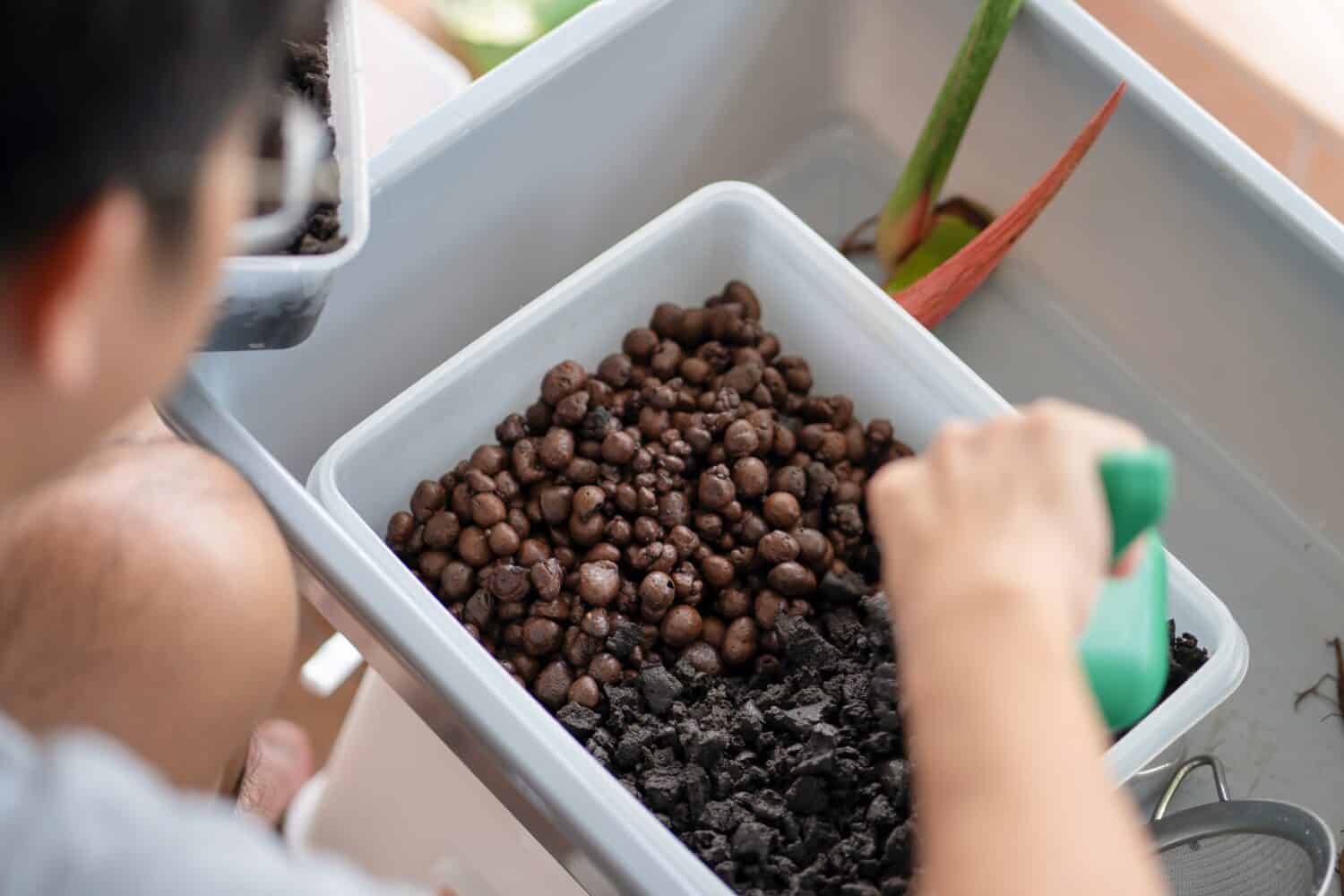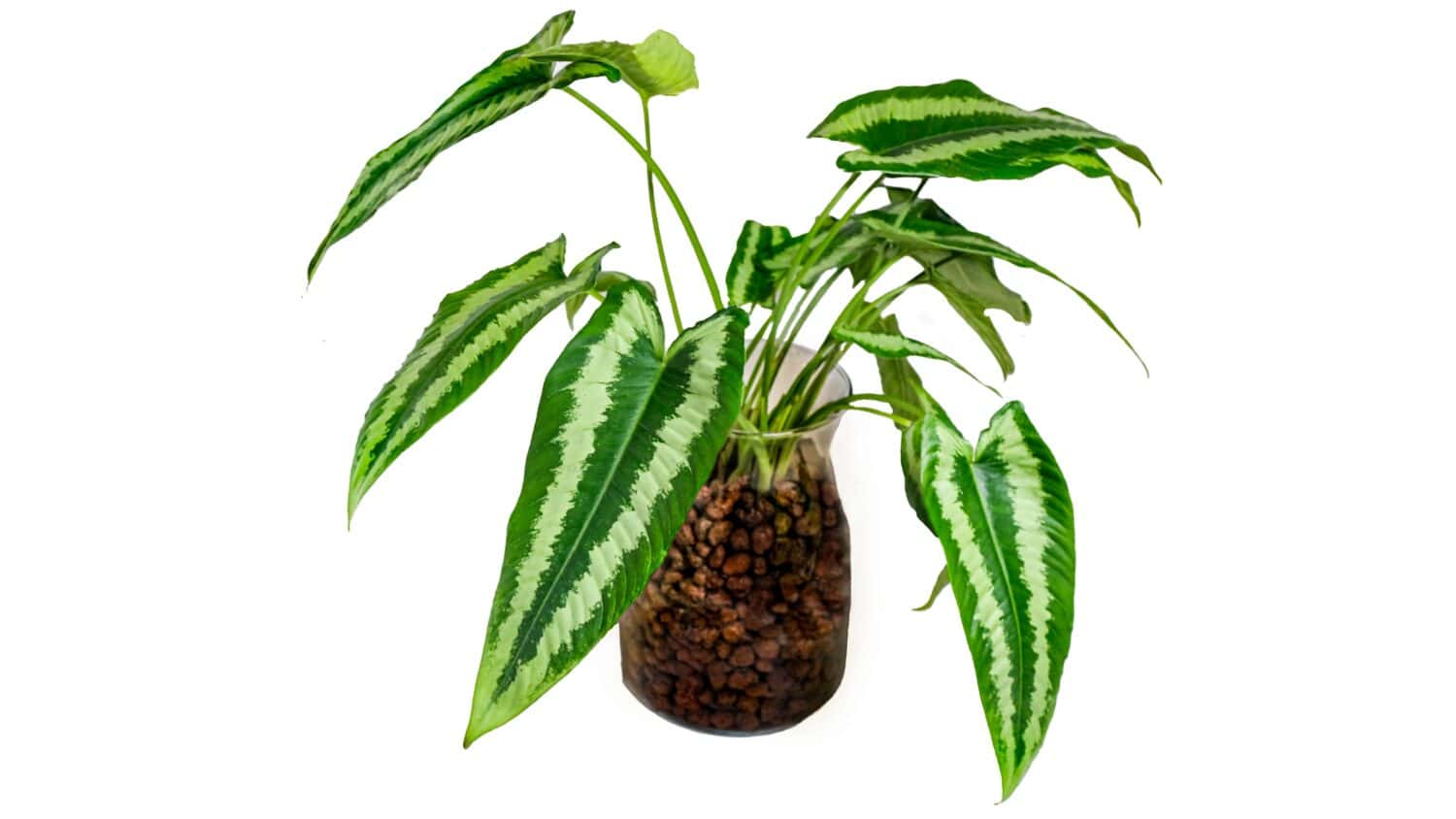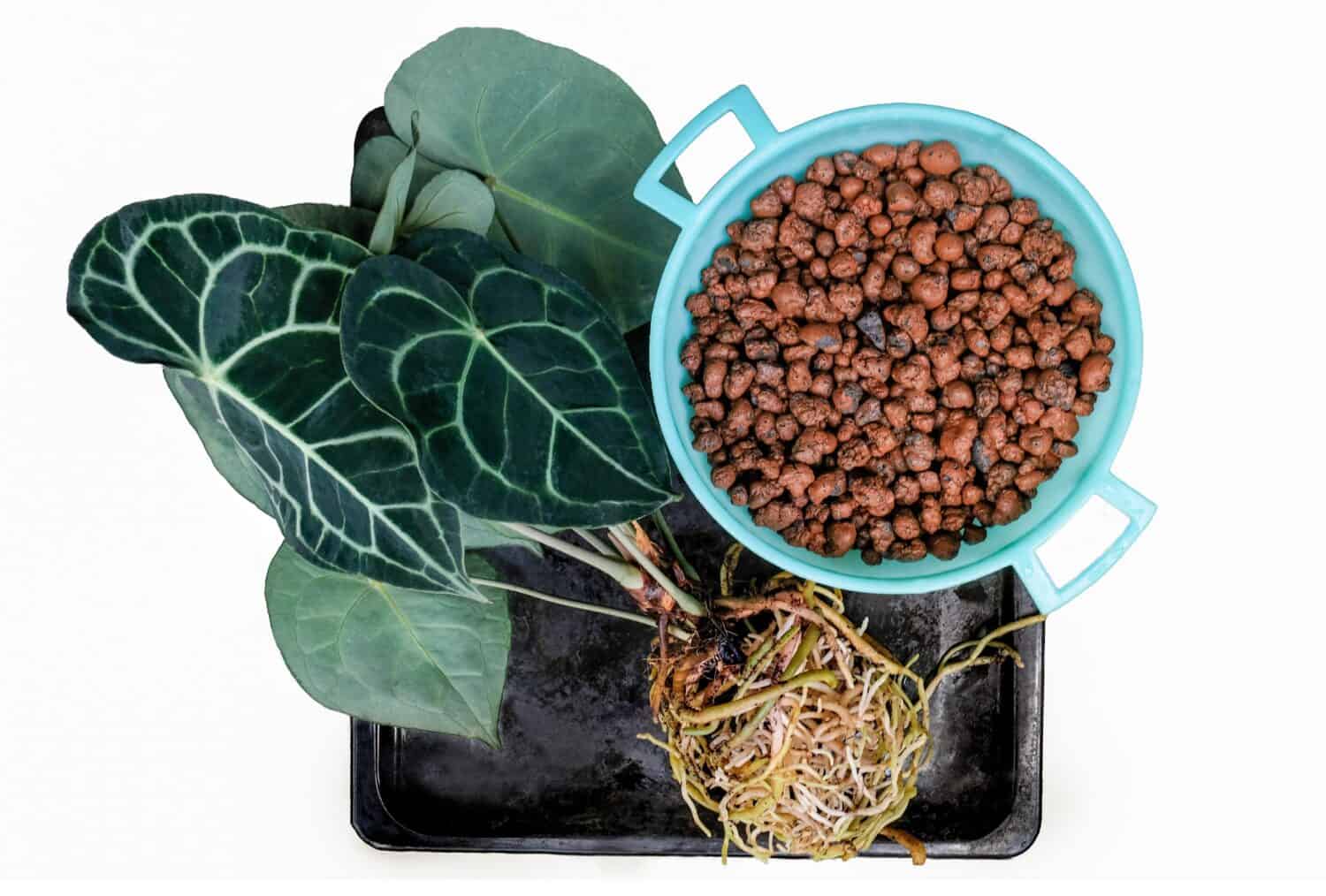What is LECA, and how can it enhance your houseplant experience? Discover the benefits and usage tips, and unleash the potential of this innovative planting medium.
What is LECA?

Lightweight expanded clay aggregate, or LECA, is a semi-hydroponic growing medium for plants.
©Anastasia_Kot/Shutterstock.com
LECA is an acronym for lightweight expanded clay aggregate. What a mouthful. No wonder they created an acronym. LECA is a type of clay pellet made from natural clay that has been fired at a high temperature in a rotary kiln. This process produces small, lightweight balls or pellets of clay that are suitable for use as an effective growing medium and soil amendment for plants.
LECA has a number of advantages when used in houseplant cultivation. As mentioned above, it is lightweight, which makes it much easier to transport and handle than soil or other growing mediums. It also provides excellent drainage for plants that are sensitive to overwatering, as the balls are designed to hold air pockets between them, allowing water to drain away quickly. Additionally, LECA helps maintain an even moisture level in the substrate without becoming soggy and can be mixed with other substrates, such as perlite or vermiculite, to provide additional aeration and drainage.
Why Use LECA Instead of Soil?

Thoroughly soak and rinse LECA before using it.
©mokjc/Shutterstock.com
LECA is free of pests, disease, and weed seeds, making it an excellent choice for indoor plants that are sensitive to outdoor contaminants. Additionally, LECA does not compact like soil can, allowing oxygen to circulate around plant roots more easily for better development and growth. Finally, its light weight makes it easy to transport from place to place without worrying about the added strain of carrying heavy bags of potting mix or compost.
Perhaps the largest advantage is that it greatly reduces the chance of root rot. LECA contains tiny air bubbles that allow plants to absorb only the amount of water they need. The roots don’t become ‘drowned’ when you water too soon. By keeping the water reservoir at the bottom, below root level, your plant will be able to take the water it needs, and you won’t be able to over-water. In addition, LECA can help extend how long you need to wait between watering, making it great for those who have a lot of plants or worry about over-watering.
Pros and Cons of Using LECA
| PROS OF LECA | CONS of LECA |
|---|---|
| Fewer Pests | Fewer choices of pots |
| Reduces the chance of root rot | More work to begin |
| Less frequent plant maintenance | Need to buy special fertilizer |
| You can leave the plants alone when traveling | Learning curve |
| No compaction | More expensive than potting soil. |
| Fewer plant diseases | |
| Watering becomes very easy. | |
| Much more oxygen in the root zone |
How to Use LECA in Houseplants

LECA is also a great substrate for propagating cuttings.
©fujilovers/Shutterstock.com
1. Rinse
When you receive your bag of Leca, make sure you give it a thorough rinse until the water appears clear. It is recommended to do this outside so that the clay particles don’t end up clogging your sink. An added tip is to put the Leca in a mesh laundry bag and use a garden hose. It is important to note that Leca is made of clay and can be quite dusty, so never use it without prepping it first. Furthermore, never put plants in very dry Leca as it can absorb water from the roots.
2. Soak
Once you’ve rinsed the LECA, you can soak it for 24-48 hours in tap water. If you soak it for longer than 24 hours, dump out the old water and replace it with fresh water. If you prefer, you can prep all your LECA ahead of time and store it somewhere cool and dry until you need to use it again; just be sure to give it an overnight soak before using.
3. Feed
For houseplants with high nutrient requirements, a nutrient soak is a great option. Utilize filtered or distilled water and add hydro nutrients to it. Let the plant soak for 24 hours before being placed in the container.
Fertilizers labeled as “root fertilizer” are best to use with LECA because they contain necessary magnesium and calcium and have a balanced formula. Be sure to avoid fertilizer with urea or chlorides because those can accumulate in the LECA and cause harm to the roots.
4. Plant
Potting a plant in LECA is much like potting in organic media. Remember to make sure the LECA is wet when you are potting. To make potting multiple plants easier, fill the pot three-quarters of the way full with LECA and then submerge it in water. Arrange the roots so they don’t touch each other to prevent rot from spreading. To do this, you may need to trim any really long roots. LECA utilizes capillary action to draw water and store it inside its clay interior. Once placed in water, it will absorb as much as it can until it is full. The plant’s roots will then draw the water away, and the LECA will absorb even more from beneath.
5. Water and Grow
LECA works best in pots that have a water reservoir at the bottom. After having your houseplant in its pot, fill the reservoir immediately. Some people use plain tap water, some people use rainwater, and others use a nutrient solution. This decision will depend on the needs of the plant.
If you are growing a succulent, a cactus, or another plant that likes a drier environment, you may prefer the shower method. Here, you will leave the reservoir empty of water and shower the plant with water from above (like rain). After the plant is used to growing in LECA and has recovered from the transplanting, you can switch to the reservoir method. This usually takes a few weeks.
How Do You Transfer a Plant From Soil to LECA?

When transferring a plant from soil to LECA, remove as much of the soil as possible to avoid root rot.
©fujilovers/Shutterstock.com
Prior to transferring your plant, you need to thoroughly clean and hydrate the LECA by soaking and rinsing it, as in the instructions above.
Remove the Soil
Thoroughly clean the plant roots by removing all soil, bark, moss, and any other organic material. You can use a tap, hose, or a gentle spray from a squeeze bottle.
When transplanting a houseplant from soil to LECA, it is important to take off as much of the organic matter from the roots as possible. If some soil remains, it can absorb too much water from the LECA and lead to root rot. It is important to remember that LECA holds 30% of its weight in water, whereas organic matter in potting mixes can hold 2 to 4 times more. Taking proper preparation steps can help prevent root rot from being incorrectly blamed on the LECA.
What Types of Plants Grow in LECA?

Monsteras are perfectly happy growing in LECA or another semi-hydropic substrate.
©Isabella Wand/Shutterstock.com
Switching a houseplant from soil to LECA can cause it to experience transplant shock, which may lead to its decline. Nevertheless, some plants are hardier and adjust quicker to this new environment, as their roots grow faster. Moving from water to LECA is the simplest transition.
Many different plant varieties grow well in Leca. These plants usually enjoy having their soil dry out before being watered again, they tend to sprout roots easily, and they are fairly durable when it comes to frequent handling. Additionally, they prefer airy substrates with lots of oxygen.
The following plants thrive in a semi-hydroponic substrate, like LECA.
- Sansevieria
- ZZ Plant
- Spider Plant
- Syngonium
- Orchid
- Pothos
- Philodendron
- Monstera
- Alocasia
- Hoya
- Calathea
- Maranta
What Types of Pots Work With LECA?

Wick-watering does not have to be expensive. You can reuse and recycle old materials.
©Olya Detry/Shutterstock.com
LECA works well in self-watering and wick-watering pots. These pots come in 4 and 6-inch sizes, some of which cost less than $3. You can also find hanging versions of these pots, perfect for trailing or vining plants. For the most effortless way to water your plants, opt for transparent self-watering pots that allow you to look into the water reservoir. However, keep in mind that the excess light can cause algae growth, so it’s essential to practice good hygiene when gardening.
You don’t need to purchase anything fancy to use LECA – you can just reuse jars or plastic cups. When using a jar or vase for the submerged method, make sure that it is larger at the top than the bottom to make it easier to remove the plant. Otherwise, you may have to break the jar to get the plant out. As an alternative, nursery pots can be used when propagating or caring for small plants or a large collection of plants. Clear pots are recommended for this purpose so that you can monitor the root development and water levels.
The photo featured at the top of this post is © Anastasia_Kot/Shutterstock.com
Thank you for reading! Have some feedback for us? Contact the AZ Animals editorial team.







